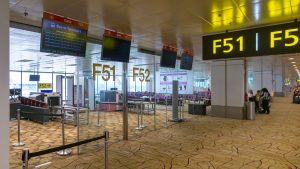737 MAX may be back in European skies by December

What we'll be covering
This article originally appeared on AirlineGeeks.
The European Union Aviation Safety Agency (EASA) has reportedly given approval for the return of the Boeing 737 MAX to the region’s skies. The agency had reported on Sept. 11 that test flights of the aircraft had been completed in Vancouver, Canada due to COVID restrictions. Data from those test flights has subsequently been analyzed by a Joint Operations Evaluation Board (JOEB) in the U.K.
Bloomberg reported comments from Patrick Ky, executive director of EASA, saying that the analysis “is showing that this is safe, and the level of safety reached is high enough for us.” A draft airworthiness directive is expected to be issued by EASA soon, and the process then calls for four weeks of public comment before the aircraft is given the all-clear to operate in European airspace.
The latest variations of Boeing’s top-selling aircraft were grounded in March 2019 after crashes in Indonesia and Ethiopia attributed to the failure of the mechanical angle-of-attack sensors. The sensors indicate the Angle of Attack (AOA), which is the angle between the aircraft’s wing and the oncoming airflow, to help pilots detect and respond to aerodynamic stalls. But in the two crashes, the system, which previously only needed a reading from one stall sensor to activate, responded to erroneous errors, sending planes into nosedives that pilots could not respond to in time.

After the global grounding of all 737 MAX aircraft and investigation data from the Lion Air crash in October 2018 and the Ethiopian Airlines crash in March 2019, the U.S. Federal Aviation Administration (FAA) issued a caution to airlines, aircraft-maintenance companies and manufacturers. In relation to the AOA sensors, the caution stated: “It is imperative that all operators are aware of the criticality of AOA sensors and the potential for damage during normal operations, maintenance procedures, servicing procedures, and any other procedures around an aircraft.”
EASA has called for the development of a so-called ‘synthetic sensor to add redundancy,’ which will take up to two years. This software solution will be required for the MAX 10 variant of the Boeing 737, which is expected to be certified in 2022. Other versions of the MAX will be retrofitted.
“What we discussed with Boeing is the fact that with the third sensor, we could reach even higher safety levels,” Ky said. “We think that it is overall a good development which will increase the level of safety. It’s not available now and it will be available at the same time as the MAX 10 is expected to be certified.”
Prior to the grounding of the 737 MAX, just under 400 aircraft were in operation globally, including at Icelandair and Norwegian Air Shuttle, with Boeing declaring orders of over 5000 airliners to 100 airlines. Ryanair is the manufacturer’s largest European customer for the 737 MAX with 135 aircraft on order and the option of a further 75. The Irish carrier had expected its first delivery of MAX aircraft in late 2019.
This month, Ryanair Chief Executive Eddie Wilson said “the first of those we would hope to arrive in very early 2021,” per The BBC. This would see the now-rebranded 737-8200 aircraft flying for the airline, Europe’s biggest, in the summer of 2021. International Airlines Group (IAG), the parent company of British Airways, signed a letter of intent for 200 737 MAX with deliveries commencing in 2022. However, it is unknown whether this will convert into a full order given the downturn in demand due to the coronavirus pandemic.
* Featured image courtesy of Chuyi Chuang, AirlineGeeks



Community